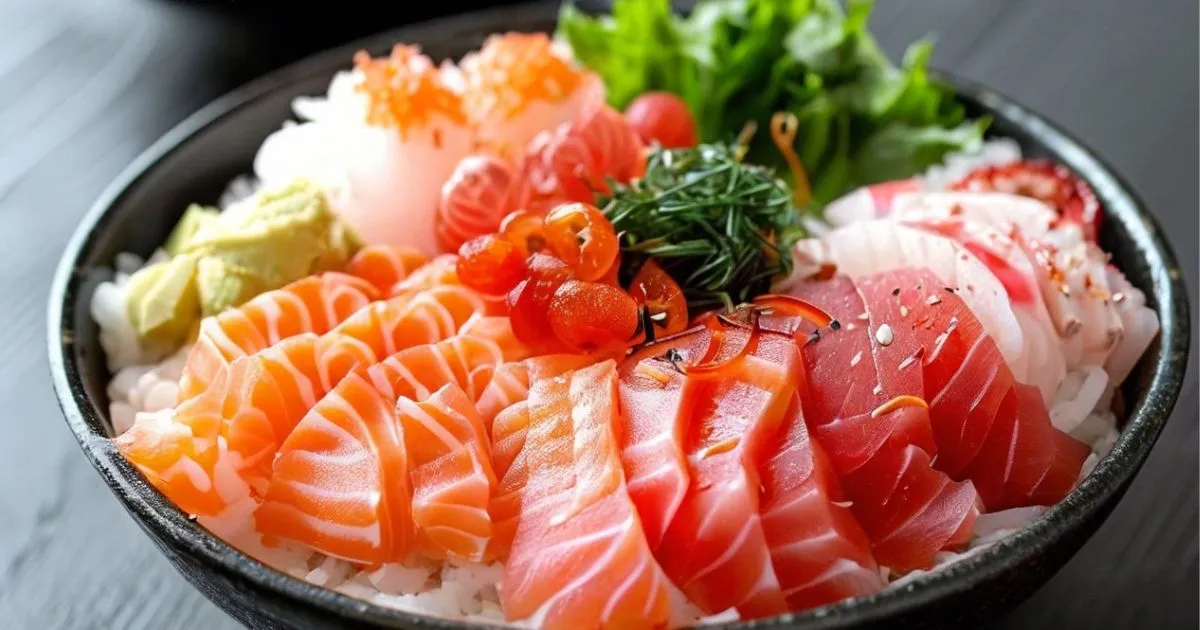Chirashi Recipe: Traditional Japanese Sushi Bowl
Table of Contents
A Taste of Home in Every Bowl
Imagine sitting down at a beautifully set table, the vibrant colors of fresh fish and vegetables laid out before you. As you take in the fragrant aroma of seasoned sushi rice, you feel a comforting sense of nostalgia wash over you. Whether it’s a cherished family gathering or a peaceful Sunday brunch, chirashi brings a piece of Japan to your home. This traditional sushi bowl, with its colorful assortment of sashimi, fresh vegetables, and fragrant rice, offers a perfect blend of taste and visual appeal. It’s more than just a meal; it’s a celebration of flavors, culture, and memories waiting to be created.
In this article, we’ll explore the art of preparing chirashi recipes—understanding its components, mastering the assembly, and discovering tips for creating your unique version. You’ll not only learn how to make this delightful dish but also uncover its history, health benefits, and much more.
What is Chirashi?
Chirashi recipes, or “scattered sushi,” is a vibrant and colorful Japanese dish that features a base of sushi rice topped with an array of ingredients. Unlike traditional sushi, which is rolled or pressed, chirashi presents its toppings in a visually striking manner, allowing you to appreciate each element’s unique flavor and texture. This dish is often enjoyed during celebrations, such as Hanami (flower viewing) or festivals, making it a popular choice for special occasions.
Key Ingredients
A traditional chirashi recipes bowl includes several key ingredients that contribute to its distinctive flavor and appearance:
- Sushi Rice: The foundation of chirashi recipe, seasoned with vinegar, sugar, and salt to create a slightly sweet and tangy flavor.
- Assorted Sashimi: Fresh fish such as salmon, tuna, and shrimp provide a rich and savory experience.
- Vegetables: Fresh vegetables like cucumber, carrots, and avocado add crunch and color.
- Garnishes: Toppings such as pickled ginger, sesame seeds, and nori enhance the dish’s flavor and presentation.
The Essential Components of Chirashi
Sushi Rice: The Foundation of Chirashi
Sushi rice is the heart of chirashi recipe, and getting it just right is essential for an authentic experience. Here’s how to prepare it:
- Ingredients:
- 2 cups of short-grain rice
- 1/4 cup rice vinegar
- 2 tablespoons sugar
- 1 teaspoon salt
- Preparation Steps:
- Rinse the Rice: Wash the rice under cold water until the water runs clear to eliminate excess starch. This step helps achieve the desired texture.
- Soak the Rice: Soak the rice in water for about 30 minutes. This helps the grains soak up moisture and ensures they cook evenly.
- Cook the Rice: Drain the soaked rice and place it in a rice cooker or pot with 2 1/2 cups of water. Cook according to the rice cooker’s instructions or bring it to a boil, then reduce to low heat and cover for about 15 minutes.
- Season the Rice: Once cooked, transfer the rice to a large bowl and let it cool slightly. In a separate bowl, mix rice vinegar, sugar, and salt until dissolved, then gently fold this mixture into the rice with a wooden spatula.
Assorted Sashimi: Choosing the Best Toppings
Selecting fresh sashimi is crucial for a delicious chirashi recipe bowl. Here are some popular options:
- Salmon: Rich in omega-3 fatty acids, salmon is a favorite for its buttery texture.
- Tuna: A leaner fish with a mild flavor, tuna offers a satisfying bite.
- Shrimp: Sweet and tender, shrimp adds a delightful contrast to the other toppings.
- Eel: Grilled eel, often glazed with a sweet soy sauce, provides a unique flavor.
- Yellowtail: This fish is known for its rich taste and smooth texture.
When purchasing sashimi, keep the following tips in mind:
- Freshness is Key: Look for bright, vibrant colors and firm texture. Steer clear of fish that looks dull or has an unpleasant smell.
- Sustainable Seafood: Consider sourcing your seafood from sustainable fisheries to support eco-friendly practices.
Vegetables and Garnishes: Adding Color and Flavor
The beauty of chirashi recipe lies in its colorful presentation, which is enhanced by fresh vegetables and garnishes. Here are some common choices:
- Cucumber: Thinly sliced or julienned for a refreshing crunch.
- Carrot: Julienne or spiralize for a sweet and crunchy addition.
- Avocado: Creamy avocado adds richness and balances the dish’s flavors.
- Pickled Ginger: Adds a tangy bite that complements the sashimi.
To prepare the vegetables attractively, consider the following techniques:
- Color Coordination: Choose vegetables that contrast with the colors of your sashimi for a visually striking presentation.
- Creative Cuts: Experiment with different cutting techniques, such as julienne, thin slices, or wedges, to add interest to your dish.
How to Assemble Your Chirashi Bowl
Step-by-Step Instructions
Creating a beautiful chirashi recipe bowl is simple and allows for personal creativity. Follow these steps to assemble your dish:
- Prepare the Sushi Rice: Follow the instructions outlined earlier to ensure the rice is perfectly seasoned and cooled.
- Arrange Sashimi and Vegetables:
- In a large serving bowl, spread a generous layer of sushi rice as the base.
- Neatly arrange your chosen sashimi and vegetables on top of the rice, creating an appealing visual display.
- Add Final Touches:
- Sprinkle garnishes like sesame seeds, sliced nori, and pickled ginger on top for added flavor and decoration.
Tips for Presentation
The art of presentation is a significant aspect of Japanese cuisine. Here are some tips to elevate your chirashi recipe:
- Bowl Selection: Choose a shallow, wide bowl that allows the ingredients to be displayed beautifully.
- Layering: Create height by stacking some toppings or arranging them in a circular pattern around the bowl’s edge.
- Use of Color: Incorporate a variety of colors and textures to make the dish visually appealing. Aim for a balance of warm and cool colors.
Frequently Asked Questions (FAQs)
What is the difference between chirashi and sushi?
Chirashi recipe and sushi are both beloved Japanese dishes, but they differ significantly in presentation. While sushi involves rolled or pressed rice combined with fillings, chirashi features a base of sushi rice topped with an assortment of sashimi, vegetables, and garnishes. This open-style presentation allows you to enjoy a variety of flavors in each bite.
Can chirashi be made vegetarian?
Absolutely! Vegetarian chirashi recipe can be just as delicious and visually appealing. Instead of sashimi, you can use a variety of fresh vegetables, tofu, and even vegan protein options like tempeh. Here are some great substitutes:
- Tofu: Grilled or marinated tofu offers a satisfying texture and flavor.
- Mushrooms: Sautéed or grilled mushrooms provide an umami-rich component.
- Fruits: Add slices of mango or kiwi for a sweet twist.
How can I store leftover chirashi?
To keep your chirashi fresh, follow these storage tips:
- Refrigerate Promptly: If you have leftovers, store them in an airtight container and refrigerate within two hours of preparation.
- Separate Components: For the best taste and texture, store sashimi, rice, and vegetables separately. This will prevent the rice from becoming soggy and the sashimi from losing freshness.
- Consume Quickly: It’s best to eat leftover chirashi within one to two days for optimal freshness.
Nutritional Benefits of Chirashi
Chirashi recipe isn’t just delicious; it’s also packed with nutritional benefits. Let’s examine some of the essential components:
- Omega-3 Fatty Acids: Found in fatty fish like salmon and tuna, omega-3s are essential for heart health and brain function.
- Vitamins and Minerals: Fresh vegetables provide a wealth of vitamins, such as vitamin A from carrots and vitamin K from cucumbers, which are vital for overall health.
- Protein: Sashimi is an excellent source of high-quality protein, helping to keep you full and satisfied.
Nutritional Comparison Table
| Ingredient | Calories | Protein (g) | Fat (g) | Carbohydrates (g) | Vitamins |
| Salmon Sashimi | 206 | 22 | 12 | 0 | A, D |
| Tuna Sashimi | 132 | 28 | 1 | 0 | B12 |
| Shrimp | 60 | 12 | 0.5 | 0 | D, B12 |
| Cucumber | 16 | 1 | 0.2 | 4 | K |
| Carrot | 41 | 1 | 0.2 | 10 | A |
Create Your Own Chirashi Experience
As you embark on your chirashi-making journey, remember that this dish is as much about creativity as it is about tradition. Don’t be afraid to experiment with ingredients and presentation. Perhaps you’ll find that a unique topping or a twist on the traditional recipe becomes your signature version of chirashi recipe.
Call to Action
Now that you have all the knowledge and inspiration at your fingertips, it’s time to start cooking! Gather your ingredients, invite friends or family, and share the joy of creating chirashi together. Take photos of your beautiful creations and share them on social media with the hashtag #MyChirashiBowl. We’d love to see your unique interpretations!
Feel free to explore our other delicious recipes, and don’t forget to subscribe for more culinary inspiration delivered right to your inbox. Enjoy your chirashi adventure!
Conclusion
In this article, you’ve learned about chirashi—its history, ingredients, and the art of assembly. This traditional Japanese sushi bowl is not just a meal; it’s a celebration of flavors, colors, and cultural heritage. By following the tips and recipes outlined here, you can create a beautiful chirashi recipe bowl that reflects your taste and creativity. Embrace the opportunity to share this dish with loved ones and build lasting memories around the table. So, gather your ingredients and embark on your culinary journey!

